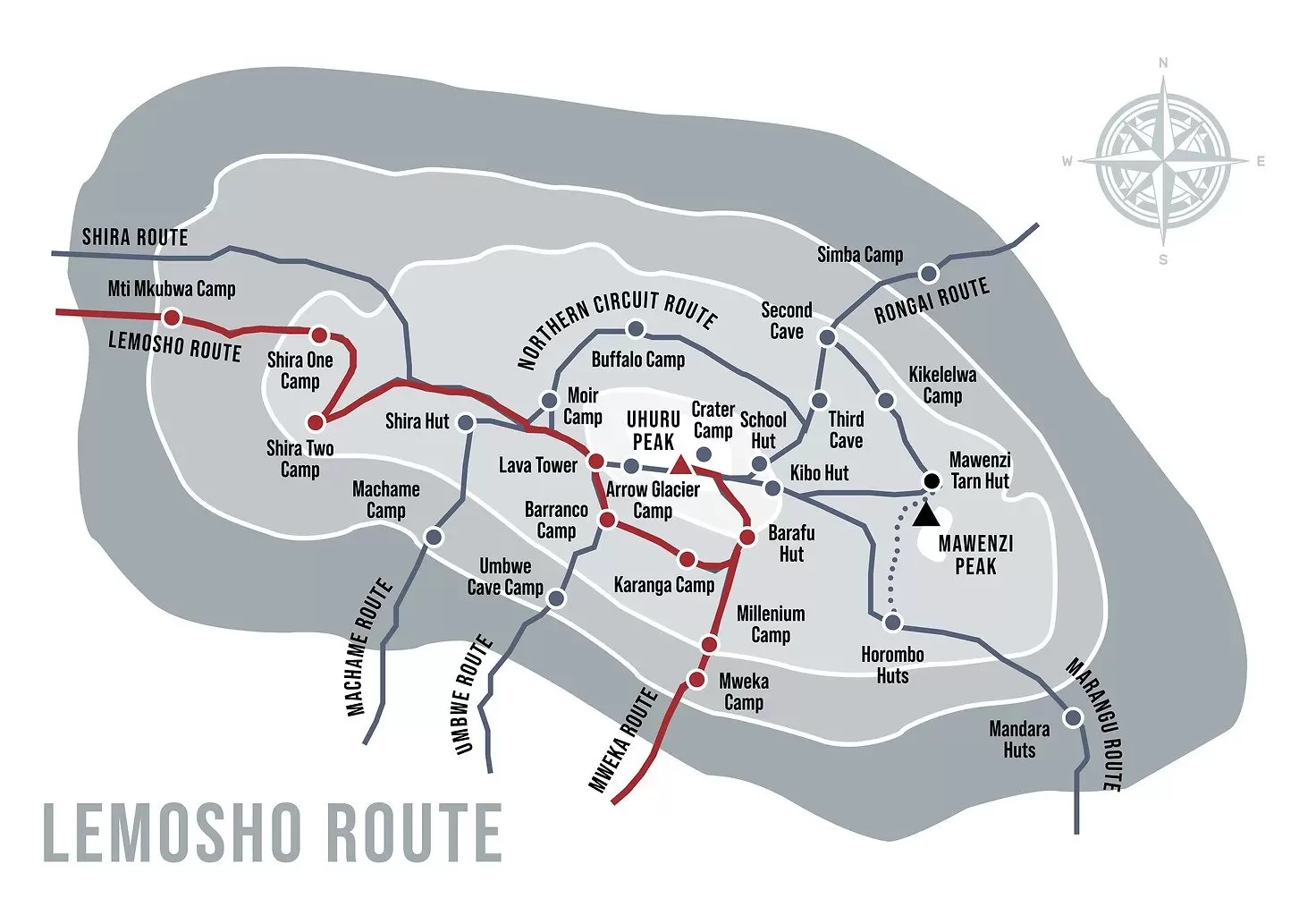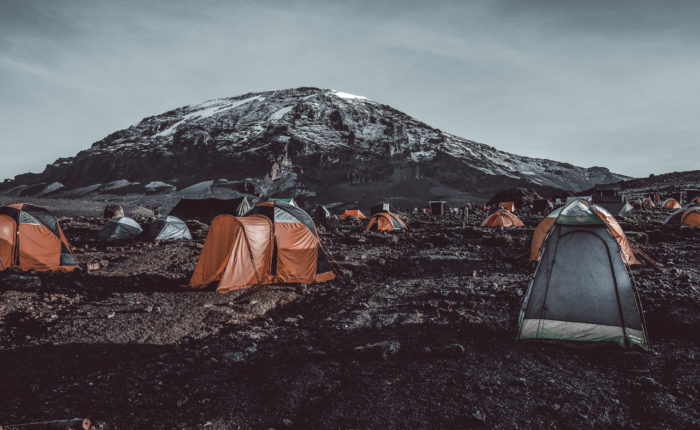TRIP – ITINERARY
Day 00: Arrival
Upon your arrival at Kilimanjaro International Airport, you’ll meet our office representative, followed by an hour drive to the hotel in Moshi Town. After having a short rest at the hotel, our mountain guide will meet you to check with your climbing gears and equipment. If some gears will be missing, our guide will help you on how to rent those missing gears from the rental shops.
Day 1 : Umbwe Gate to Cave Bivouac Camp
At 8am, leave Moshi for Umbwe Gate, where you will meet our porters, guides, and cooks who will spend the next six days trekking with you to Uhuru Peak, the roof of Africa. After arriving, wait at the gate while we register your climb and the porters and guides make final preparations. Your first day’s destination is Cave Bivouac Camp, approximately 6 hours from the gate. The trail is steep and can be slippery in some places. Hike through the moss-covered trees of Kilimanjaro’s cloud forest. The forest will thin later in the hike, and heathers, tall grasses, and wildflowers will come into view. Porters and cooks will walk ahead to set up the camp in time for your arrival.
- Elevation: 1,800m/5,905ft to 2,850m/9,350ft
- Hiking Time: Approximately 6 hours
- Distance: ~11 km
- Difficulty: Moderate to Difficult (steep and slippery in places)
- Habitat: Cloud forest, moss-covered trees, heathers, tall grasses, wildflowers
Day 2 : Cave Bivouac to Barranco Camp
The first section of the trail continues following the ridge. After leaving the forest, continue through open moorlands until reaching Barranco Camp. Barranco is generally regarded as the most scenic campsite on the Umbwe Trail as it’s surrounded by giant senecios and lobelias. As Barranco is in a valley, the sun rises later than at the other camps.
- Elevation: 2,850m/9,350ft to 3,950m/12,960ft
- Hiking Time: Approximately 6-7 hours
- Distance: ~8 km
- Difficulty: Moderate
- Habitat: Moorland, giant senecios, lobelias
Day 3 : Barranco Camp (Acclimatization Day)
Extra day for acclimatization. Adding this day will ease your effort and amplify your acclimatization.
- Elevation: 3,900m/12,800ft
- Hiking Time: N/A (Rest and Acclimatization)
- Distance: N/A
- Difficulty: N/A
- Habitat: Moorland
Day 4 : Barranco Camp to Karanga Valley
Leave Barranco Camp after breakfast for Karanga Valley. The day begins with a 1.5-hour scramble up the Barranco Wall. This is the hardest part of the day, and in some places, you may have to use your hands to aid your climb. After reaching the top, hike through fairly level terrain before making a short but steep descent into the green Karanga River Valley.
- Elevation: 3,950m/12,960ft to 4,200m/13,780ft
- Hiking Time: Approximately 4-5 hours
- Distance: ~5 km
- Difficulty: Moderate (scramble up Barranco Wall)
- Habitat: Moorland, alpine desert
Day 5 : Karanga Valley to Barafu Camp
After breakfast, begin the hike to Barafu Camp. On the way to Barafu, view several of Kibo’s glaciers as well as the junction that connects the descent route, Mweka, with the Machame trail. During the hike, pass by the Heim, Kersten, and Decken Glaciers. Although the trail to Barafu passes through alpine desert with little vegetation, Barafu Camp offers stunning views of Kibo and Mawenzi peaks. Try to sleep after finishing dinner as you will wake before midnight for your summit hike.
- Elevation: 4,200m/13,780ft to 4,600m/15,100ft
- Hiking Time: Approximately 4-5 hours
- Distance: ~4 km
- Difficulty: Moderate
- Habitat: Alpine desert
Day 6 : Barafu Camp to Uhuru Peak to Mweka Camp
Around midnight, begin the final ascent to Uhuru Peak. Hike by the light of your headlamp for the next six hours. The ascent to the crater rim is the most challenging part of the entire trek. The trail is very steep until you reach the crater rim at Stella Point. The hike from Stella Point to Uhuru Peak is a gradual climb and, as far as hikes go, not very difficult. The altitude, however, makes the hike long and tiring. The crater rim hike takes approximately one hour. Upon reaching Uhuru, take photos of your guide and group at the peak before beginning the descent to Mweka Camp. On the way down from Uhuru, enjoy views of the mountain, crater, clouds, and glaciers. At Barafu Camp, eat breakfast and take a short break. You still have another three to five hours to go before reaching Mweka Camp.
- Elevation: 4,600m/15,100ft to 5,895m/19,340ft (Uhuru Peak), then down to 3,100m/10,170ft (Mweka Camp)
- Hiking Time: 8-10 hours to Uhuru Peak, then 3-5 hours to Mweka Camp
- Distance: ~18 km total
- Difficulty: Very Difficult (steep ascent to summit)
- Habitat: Arctic summit zone, then descent through alpine desert to moorland
Day 7 : Mweka Camp to Mweka Gate
After breakfast, finish the trek with a hike through the forest to Mweka Gate. The trail may be slippery following rain. Our vehicles will meet you at the lower station of Mweka Gate to take you back to Moshi.
- Elevation: 3,100m/10,170ft to 1,500m/4,920ft
- Hiking Time: Approximately 4-5 hours
- Distance: ~10 km
- Difficulty: Easy to Moderate (downhill)
- Habitat: Forest
TOUR ROUTE MAP

PRICE CHARGED FOR THIS TOUR
- $ 2500 per single person
- $ 1900 per person in the group sharing
PRICE INCLUSION.
- Airport transfer on arrival and departure day
- 2 nights comfort stay in lodge the day before and after climbing.
- Transport to and from Mountain
- All park entrance fee +18% VAT
- All park accommodation fee + 18% VAT
- Park rescue fee
- Food on the mountain (3-meals a day)
- Non personal hiking equipment and gears
- Salary to guide, cook, and the crew.
PRICE EXCLUSION:
- Tipping
- Personal hiking gear and rentals
- Other personal expenses out of the mentioned above.
ESSENTIAL MOUNTAIN CLIMBING GEARS
50L waterproof duffle, small-size backpack, warm clothes including trouser, sweater, thermal underwear, and enough pair of warm socks, Balaclava, snow goggles, or ski sun glasses and scarf, waterproof layers, sun roof hat, warm sleeping bag, mattress, warm jacket, and a pair of gloves. Comfort mountain boots, and walking poles, Sun cream, first aid kit, a knapsack, a pair of getters and water-bottle, minimum 2litres each.
Tips for Climbing
- Acclimatization: Take it slow, listen to your body, and stay hydrated.
- Gear: Invest in quality equipment, including layers for cold temperatures and sturdy trekking boots.
- Guides and Porters: It’s advisable to climb with a reputable tour company that provides experienced guides and support staff.
- Physical Preparation: Train beforehand with hikes at elevation, endurance workouts, and strength training.
Best time of the year to go for Mount Kilimanjaro Climbing:
- June to October-peak of high season, most of the Kilimanjaro routes and hotels are crowded.
- October to December-Most of the Kilimanjaro routes are less crowded, this season may be associated with seasonal rainfall so not that much good for climbing.
December to end of February-High season most of the routes and hotels are crowded.
- March to early of June-Low season, it’s the peak of the wet season as these months are associated with heavy rainfalls so not ideal for climbing.


